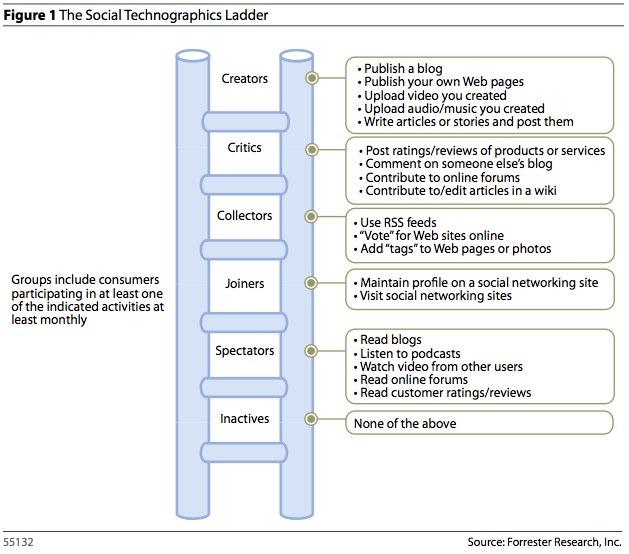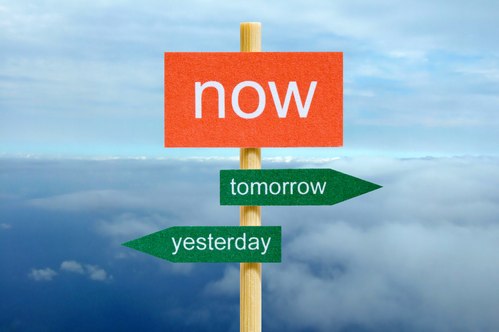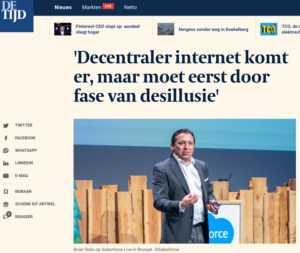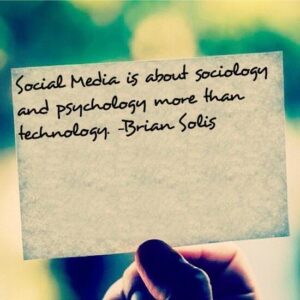
Source: Shutterstock
The Future of the Social Web is here today and we’re learning that engagement is not a matter of if or when, but to what extent, how and what value can we deliver and derive from it. The Social Web is much more than a window into information and interaction, it is a completely transformative medium that is changing how we forge relationships, interact with one another, and distribute and discover information. In many ways, the online social revolution is reminiscent of the Industrial Revolution.
Access to free and expansive media platforms and distribution channels has democratized influence and shifted the power of authority from those who previously controlled the media to those who disseminate it.
Attention has become a precious commodity as it becomes increasingly elusive and diverted. The competition for attention is only intensifying as those who benefit from your awareness venture to attract it when and where it is focused.
According to a 2007 story in the New York Times, market research firm Yankelovich estimated that a person living in an average city 30 years ago saw up to 2,000 ad messages a day, compared with up to 5,000 today. The numbers vary depending on the source, with estimates soaring as high as 9,000 estimated impressions daily. I can only surmise that with the proliferation of socialized media, that we are also directly and indirectly exposed to messages and brands as a result of conversations transpiring within our social graph.

Source: Shutterstock
As consumers, we are starting to fathom that our attention is valuable. We are also experiencing a powerful form of validation and significance as we embrace social media to extend our networks of relevance and influence. There is a great sense of individual empowerment that exudes as a result of this realization.
The battle for attention begins where your attention is focused. For some, it’s the Facebook News Feed. For others, it’s Twitter or desktop social applications such as TweetDeck or Seesmic. These platforms are fueling an emerging category that symbolizes the Attention Dashboard, channels where information finds you, filtered and qualified by those in your social graph.
Forrester Research observed the substantial growth of social technologies in 2009, observing that four in five US online adults use social media and participate in social networks.
In a published report, The Broad Reach of Social Technologies, Sean Corcoran, Nate Elliott, Josh Bernoff, Cynthia Pflaum, and Emily Bowen documented that the most rapid growth of social adoption occurred among consumers 35 and older while young people continued to march toward a universal adoption of social applications.
The report includes an updated version of Forrester’s Social Technographics Ladder, which graphs the social technology adoption of consumers and how they specifically embrace social media.

Almost one-quarter of US online adults are Creators, people who write blogs, upload original audio or video, or post stories online. Easy-to-use blogging tools encouraged some less tech-savvy adults to create social content this year, but the majority of consumers are still consuming, not creating, content.
Half of online adults now belong to social networks like Facebook and LinkedIn, a 46% growth rate year-over-year.
Nearly everyone’s a spectator: Three in four online Americans now consume social content.
Only 18% of US online adults don’t use social tools in 2009 — down from 25% in 2008.

Regardless of adoption, however, one of the primary hurdles now and in the future is that Social Media, as popular and empowering as it is, is still a largely compartmentalized experience. Social Networks and the relationships and interactivity fostered within each are silos. The true power of social media is the portability of not just content, but relationships.
Forrester concludes that now is the time to build social marketing applications and that Interactive marketers should influence social network chatter, master social communication, and develop social assets – even if their customers are older.
The social (r)evolution calls for distributed participation. But it requires strategic engagement that is directed and governed by listening and research. The conversations tied to keywords that are important to your industry define your participation level and focus. They also reveal opportunities for contribution and resolution.

Source: Shutterstock
Now is the time to pay attention. Now is the time to learn from the behavior and interaction that defines our markets. They develop and mature with or without our participation. We too, are empowered to engage and without it, we intentionally remove ourselves from the radar screens of our influencers and customers. As such, we are either part of or absent from the decision making process.
The state of socialized media is but only a chapter in an ongoing saga that will evolve and change over time. We are forever students of new media and as a result, our roles in this production are defined by our intentions and our actions. Before we are marketers, we are consumers. And, before we are consumers, we are personages of distinction. And when we align under a common goal, mission, or voice, we can change the course of behavior.
Connect with Brian Solis on:
Twitter, FriendFeed, LinkedIn, Tumblr, Plaxo, Posterous, or Facebook
—
Click the image below to buy the book/poster:
pr pr+2.0 pr2.0 public+relations marketing advertising interactive social+media socialmedia brian+solis social media media2.0 media+2.0 2.0 smo social+media+optimization marcom communication publicity advertising expert interactive spin brand branding guru social+architect







Those Forrester stats are very telling. I'm really just learning how to implement Social Media for myself and my clients and info like this is priceless. Thanks very much for this post.
Jeff
Excellent…thanks Jeff!
Great post Brian! Very interesting to see that the majority are consuming content, not creating it which makes it that much more of an opportunity for us who run blogs to seriously get the information out there.
When it comes to getting attention in this warp-speed, real-time, almost ADD like distraction age, the old ways of marketing and advertising just aren't going to cut it. Still amazes me all the big companies advertising on TV and then the majority of their ads absolutely suck. For us online business owners and marketers, we've got to do something different and more unique if we want to remain relevant or grow larger.
It's the only way to communicate and demonstrate expertise, knowledge, and insight…you're right.
Is this good info. or what? Where else could you have found this type research and who has the time do it?
This is of great value to everyone who understands the content written here.
Appreciate it…thank you very much!
Hi,
I have found a great list over 50 ways to advertise your website at:
http://www.omnistaretools.com/best-ways-to-adve…
I started using these are have been able to increase my sales.
Mark
http://www.dcdesign.com
Immensely appreciated Brian. Your post along with the data creates a clear landscape of the amazingly positive mess in front of us. –Paul
Great charts! Very effective at getting your point across.
Your post and datas are powerfull calls to action ! I am looking for similar datas in Canada, particularly in Quebec. If anyone has something similar…I will appreciate.
Thanks Brian, excellent read. RT'd to my group.
“Half of online adults now belong to social networks like Facebook and LinkedIn, a 46% growth rate year-over-year.”
Yet many people don't value social media as a platform for engagement. That's a lot of eyeballs to ignore.
As David Meerman Scott says, it's now all about “direct to consumer”. It's obviously also about self-publishing. Bottom line? Old PR is dead, and corporate reputation will now be driven by the collective – an overall reputatino driven by diverse voices of all stakeholders in what a colleague calls the digital democracy.
This just solidies the value of breaking through the clutter, gaining traction with targeted messages, and adding enough value to expand audience attention span. At 9K ad messages a day, what in our world is not an ad?
This is revolution seen from the inside. What will this look like in hindsight, 5, 10 years from now? How fast and how far does social evolution take us with the connection we have today? Sometimes I wish I went into Sociology instead of Computer Engineering so I would have the vocabulary needed to engage in this conversation.
very good stuff here. nice charts and trends.
Thanks for this excellent post. It clearly shows what´s going on in the social media world.
Keep up with the good work!
You said that “as consumers, we are starting to fathom that our attention is valuable.” I don’t think this could be more right. You also say that things are ever changing in the world of social media, but I think you generally mean that it is changing in a positive way. I believe that that is basically right, but because we are becoming more aware of our importance as information consumers, this may change social media in a negative way.
Anyone who has studied semiotics knows that people are constantly bombarded with messages of all kinds. Because we are becoming more aware of this, we may start to resent this fact and stop presenting ourselves as easy targets for companies to use social media as a business and public relations tool towards us. I think that the media is already shifting towards being more subtle because of this. If you look at some advertisements that have become viral you can probably notice this.
I am wondering if people agree with me on this aspect.
The graphs are very telling! Thank you.
The graphs are very telling! Thank you.
I really like this type of Shoes too, can you help me look at which
ugg boots
http://www.boots-outlet.us
ugg gissella boots
http://www.uggs-outlet-store.com/ugg-gissella-b…
ugg elsey boots
http://www.uggs-outlet-store.com/ugg-elsey-boot…
nike dunk
http://www.discount-nike-dunk-shoes.com
ugg classic tall stripe cable knit boots
http://www.uggs-outlet-store.com/ugg-classic-ta…
ugg boots outlet
http://www.uggs-outlet-store.com
winter boots
http://www.bootsforcheap.us
coach boots
http://www.discount-coach-outlet.com/coach-boot…
coach leather
http://www.discount-coach-outlet.com/coach-leat…
Nike Dunk mid
http://www.discount-nike-dunk-shoes.com/Nike-Du…
ugg boots
http://www.bootsforcheap.us
Read, read and read,
thankyou for this post.
And allow reading inspire you, allow reading harvest that seed in your mind and soul.
Allow creating flow out from you, and follow it with all your heart.
Excellent post and it’s great to know that creation made by others motivates creation on my own. Hope these charts and creation percentages grow higher in the years to come.
It makes me believe that a society is evolving and will continue to do so.